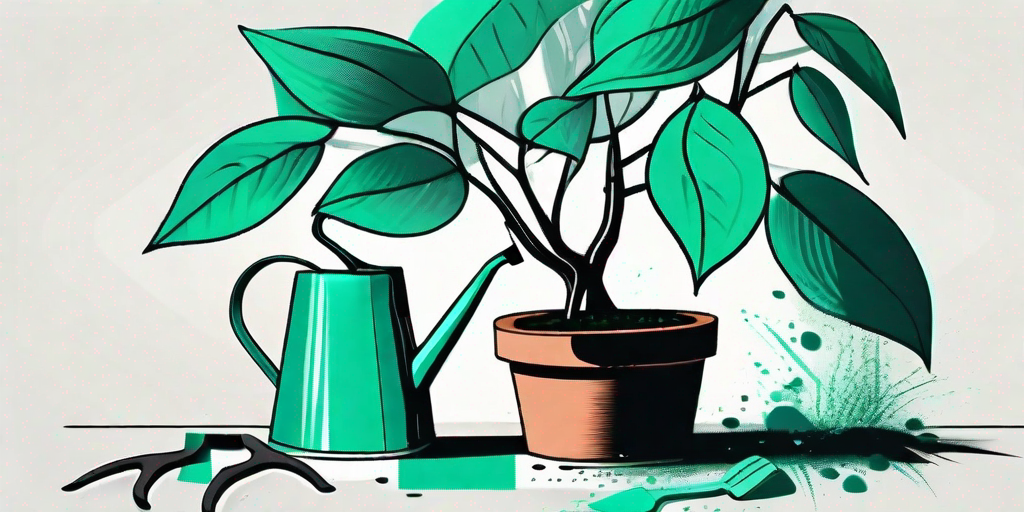
Rubber trees, also known as Ficus elastica, are a popular houseplant choice due to their robust nature and aesthetic appeal. However, like any living thing, they can sometimes exhibit signs of distress. One such sign is the curling of their leaves. But fear not, dear plant parent! This is not a death sentence for your beloved green friend. We're here to help you understand why this happens and how to fix it. So, buckle up and let's dive into the leafy world of rubber trees.
Understanding the Rubber Tree
Before we delve into the specifics of leaf curling, let's take a moment to understand the rubber tree itself. Native to Southeast Asia, the rubber tree is a tropical evergreen that can grow up to 100 feet tall in the wild. In your living room, however, it's unlikely to reach such towering heights. Unless, of course, your living room is a rainforest, in which case, we need to have a chat about your interior design choices.
These plants are known for their glossy, dark green leaves that can grow up to 12 inches long. They're also known for their resilience and adaptability, making them a great choice for those of us who don't exactly have a green thumb. But even the hardiest of plants can run into issues, and the rubber tree is no exception.
Why Do Rubber Tree Leaves Curl?
There are several reasons why your rubber tree's leaves might be curling. Let's break them down one by one, shall we?
Underwatering
While rubber trees are relatively drought-tolerant, they still need a certain amount of water to thrive. If the plant doesn't get enough water, its leaves may start to curl as a way to conserve moisture. It's like the plant version of curling up under a blanket when you're cold.
Check the soil of your rubber tree. If it's dry to the touch, then your plant is probably thirsty. Give it a good drink and see if the leaves start to uncurl.
Overwatering
On the flip side, too much water can also cause leaf curling. Overwatering can lead to root rot, which in turn can cause the leaves to curl and yellow. If the soil is soggy and the leaves are curling, you might be dealing with an overwatering issue.
Remember, rubber trees are like Goldilocks – they like their water just right. Not too much, not too little, but just the right amount.
Incorrect Light Levels
Rubber trees love bright, indirect light. Too much direct sunlight can scorch the leaves, causing them to curl and brown. On the other hand, too little light can stunt the plant's growth and lead to leaf curling.
So, if your rubber tree is sitting in the direct path of the midday sun or hidden away in a dark corner, you might want to reconsider its location.
How to Fix Curling Leaves
Now that we've identified the possible causes of leaf curling, let's look at how to fix them. Because we're not just about diagnosing problems here, we're about solving them too!
Adjust Your Watering Routine
If underwatering is the issue, start by watering your rubber tree more frequently. If overwatering is the problem, cut back on watering and let the soil dry out between waterings. Remember, the goal is to keep the soil consistently moist, but not waterlogged.
And don't forget to check the drainage of your pot. A pot without proper drainage can lead to waterlogged soil and root rot, which is a surefire way to kill your plant.
Change the Plant's Location
If incorrect light levels are causing the leaf curling, move your rubber tree to a location with bright, indirect light. Avoid placing it in direct sunlight or in a dark corner. Remember, your rubber tree is a diva – it wants the spotlight, but not too much of it.
And if you're not sure what "bright, indirect light" means, think of it this way: if you can comfortably read a book in the location without straining your eyes, your rubber tree will probably like it there.
FAQs
Now, let's tackle some frequently asked questions about rubber trees and their leaf curling tendencies.
Can curled leaves be uncurled?
Yes, curled leaves can often be uncurled by addressing the underlying issue causing the curling. However, if the leaves have been curled for a long time, they may not fully uncurl. In this case, it's best to focus on preventing further curling.
Can I prune curled leaves?
Yes, you can prune curled leaves if they're severely damaged or if you simply don't like the look of them. However, pruning should be done sparingly, as it can stress the plant.
How often should I water my rubber tree?
This depends on the size of your plant, the size of your pot, and the conditions in your home. However, a good rule of thumb is to water your rubber tree when the top inch of soil is dry.
In Conclusion
So there you have it, folks! The mystery of the curling rubber tree leaves has been unraveled. Remember, a little bit of leaf curling is not the end of the world (or your plant). With a bit of detective work and some simple adjustments, your rubber tree can be back to its glossy, uncurled self in no time.
And remember, when in doubt, don't be afraid to ask for help. There's a whole community of plant lovers out there who are more than willing to lend a hand. Or a leaf. Or a watering can. You get the idea.















